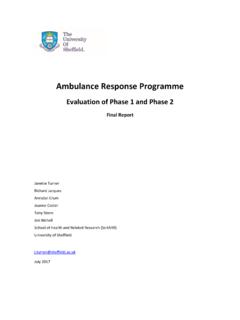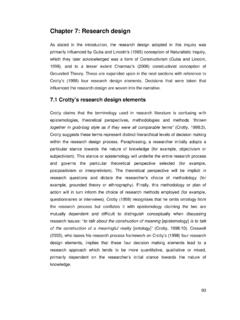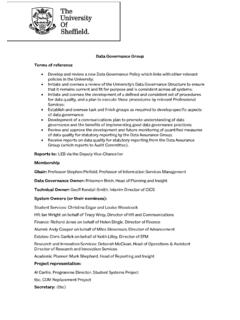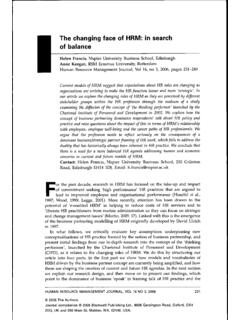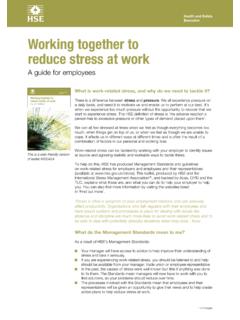Transcription of CIPD Mentoring Factsheet - University of Sheffield
1 Mentoring CIPD Factsheet Revised February 2009 This Factsheet gives introductory guidance. It: explains what Mentoring is and how it differs from coaching introduces some of the ways in which Mentoring can be beneficial describes the qualities and characteristics required for a productive Mentoring approach briefly introduces some case studies of successful Mentoring explains the role HR plays in managing Mentoring activities includes the CIPD viewpoint. What is Mentoring ? Mentoring is a long standing form of training, learning and development and an increasingly popular tool for supporting personal development. In our Learning and development survey 20081 we identified coaching and Mentoring together. See the full results of our survey: However, Mentoring is a distinct activity which has become a widespread development tool. We all know of famous Mentoring relationships.
2 Ian Botham for example was mentored by Brian Close, Kevin Keegan by the great Bill Shankly. There are many business Mentoring relationships, notably Chris Gent and Arun Sarin at Vodafone and there are many more examples from politics and other fields. A recent Times article2 offered the opportunity for readers to be mentored for example in theatre directing, novel writing, entrepreneurship and other high profile fields, often by celebrity mentors. This often leads to the popular belief that Mentoring can only be carried out by the best in the field. To paraphrase Clutterbuck, who has written extensively on Mentoring , anyone can be a mentor if they have something to pass on and the skills, time and commitment to do it. There is some confusion about what exactly Mentoring is and how it differs from coaching. Broadly speaking, the CIPD defines coaching as developing a person s skills and knowledge so that their job performance improves, hopefully leading to the achievement of organisational objectives.
3 It targets high performance and improvement at work, although it may also have an impact on an individual s private life. It usually lasts for a short period and focuses on specific skills and goals. 3 Traditionally, Mentoring is the long term passing on of support, guidance and advice. In the workplace it has tended to describe a relationship in which a more experienced colleague uses their greater knowledge and understanding of the work or workplace to support the development of a more junior or inexperienced member of staff. This comes from the Greek myth where Odysseus entrusts the education of his son to his friend Mentor. It s also a form of apprenticeship, whereby an inexperienced learner learns the "tricks of the trade" from an experienced colleague, backed-up as in modern apprenticeship by offsite training. Mentoring is used specifically and separately as a form of long term tailored development for the individual which brings benefits to the organisation.
4 The characteristics of Mentoring are: It is essentially a supportive form of development. It focuses on helping an individual manage their career and improve skills. Personal issues can be discussed more productively unlike in coaching where the emphasis is on performance at work. Mentoring activities have both organisational and individual goals. The following table, adapted from Alred et al4, highlights the differences between Mentoring and coaching. It is separate and distinct from coaching, but coaching and Mentoring can often overlap. Mentoring Coaching Ongoing relationship that can last for a long time Relationship generally has a short duration Can be more informal and meetings can take place as and when the mentored individual needs some guidance and or support Generally more structured in nature and meetings scheduled on a regular basis More long term and takes a broader view of the person.
5 Often known as the 'mentee' but the term client or mentored person can be used Short-term (sometimes time bounded) and focused on specific development areas/issues Mentor usually passes on experience and is normally more senior in organisation Not generally performed on basis that coach needs direct experience of clients formal occupational role The focus is on career and personal development Focus generally on development/issues at work Agenda is set by the mentored person with the mentor providing support and guidance to prepare them for future roles Agenda focused on achieving specific, immediate goals Revolves more around developing the mentee professionally Revolves more around specific development areas/issues Developing a Mentoring approach In Everyone needs a mentor5 Clutterbuck describes how Mentoring works and the business benefits of the approach.
6 Benefits to the organisation are: significant impact upon recruitment and retention (one study found that the loss of young graduates in the first expensive post training year was cut by two thirds). effective succession planning makes organisations adapt to change increased productivity through better engagement and job satisfaction. Benefits to the mentored person are: development outcomes which may include, knowledge, technical and behavioural improvements better management of career goals developing wider network of influence increased confidence and self awareness which helps build performance and contribution mentors also benefit from the satisfaction of developing their colleagues and of passing on their knowledge, skills and expertise line managers and HR also benefit from better employee focus and engagement. A simple three stage model Alred et al4 identify a simple model of Mentoring which operates on a three stage basis: exploration to explore issues which are identified by the mentored individual new understanding action planning.
7 In each stage there are responsibilities for both the mentor and the 'mentee'. The tables below focus on the main strategies and methods required of the mentor. Exploration Strategies Methods Take the lead Listen Pay attention to relationship and develop it Ask open questions Clarify the aims and objectives of Mentoring Negotiate an agenda Support and counsel New understanding Strategies Methods Support and counsel Listen and challenge Give constructive feedback Ask open and closed questions Coach and demonstrate skills Recognise strengths and weaknesses Establish priorities Identify developmental needs Give information and advice Share experience and tell stories Action planning Strategies Methods Examine options for action and their consequences Encourage new and creative way of thinking Attend to the Mentoring process and the Help to make decision and solve relationship problems Negotiate an action plan Agree action plans Monitor progress and evaluate outcomes Mentoring in
8 Organisations Clutterbuck5 outlines a number of key examples of Mentoring in practice in the workplace. The Civil Service Public Sector leader s scheme allows fast stream civil servants to pick a mentor to help in developing their leadership capability. Ericson the mobile phone company now owned by Sony uses Mentoring from top executives to help grow its future leadership talent. BAE gives its graduates a mentor for the first year of their training programme Shell Exploration uses Mentoring to develop local indigenous talent for its engineering and management activities in Brunei. Different types of Mentoring activity Developmental Mentoring This is based on helping someone to develop. The mentored employee sets the agenda based on their own development needs and the mentor provides insight and guidance helping achieve the desired goals. Sponsorship Mentoring This is a form of Mentoring where the mentee is prot g (literally 'one who is protected').
9 Here the mentor intervenes on the mentee s behalf and there is normally one way learning. The mentor is usually more senior. These relationships can break down when the power relationship changes and when the mentee stops taking advice. This is often the form of Mentoring undertaken for graduate recruits and evidenced in our 2008 Learning and development survey as being used by 85% of respondents. When is Mentoring the best development intervention? Many experts advise that Mentoring should be independent from any other training and learning activity. Again it should not be confused with coaching. Mentoring can be the best intervention in areas where the development task relates to an employee requiring much specialist, knowledge and information. However there are other contexts where it is the best intervention. Specific areas where it can be used are given in the table below.
10 Context Purpose Induction Helps people get up to speed Support for development Ensures effective learning Career progression Assist in identifying and supporting potential talent On the job learning To enhance job related knowledge and skills for the present Equal opportunity programmes To ensure proper integration and fairness of treatment Redundancy and outplacement To assist individual in managing the difficult transition New projects Help rapid assimilation and delivery New job transition Helps employee adjust Within change programmes To help people adjust to change Stakeholders and evaluation The primary relationship in any Mentoring activity is between the mentor and the individual, but this is not the only important relationship. Other key stakeholders include the person representing the organisation s interests (most frequently an HR practitioner) and the individual s manager.





